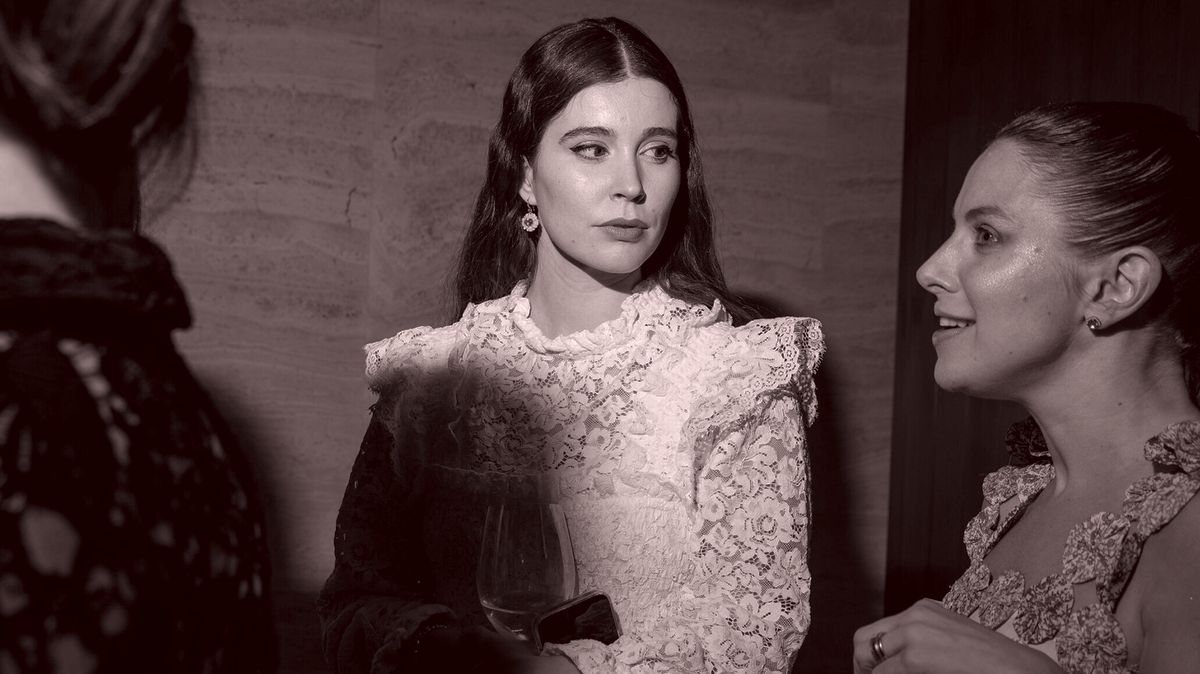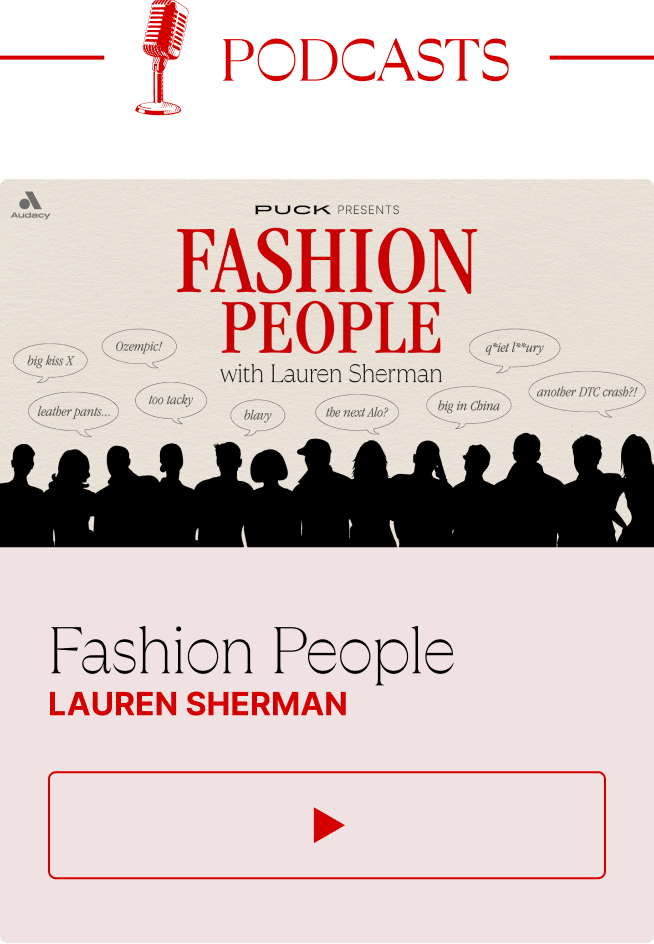Hi, and welcome back to Line Sheet. Thanks to so many of you for
responding to yesterday’s email by asking how you could help, where to donate products, etcetera. I texted Los Angeles-based designer Aurora James—founder of Brother Vellies and the Fifteen Percent Pledge, and vice chair of the Council of Fashion Designers of America—because I knew she’d have some good answers. We’ll hear more this week from Aurora, but she made one comment that I wanted to share immediately: Yes, people who lost their homes, offices, and storefronts need
things, but they’re also going to need cash. So think about where to put your actual dollars, too.
Today, Sarah “SShapiro@puck.news” Shapiro starts things off by returning to the TikTok beat, asking what the potential end of the app in the U.S. could mean for the marketers who are increasingly reliant on
its shopping platform to sell their products. She also offers a keen observation about J.Crew’s collab-ish strategy. And, finally, I’ve got some details on staff exits at WSJ.
For the main event, Sarah digs into the business of being Nell Diamond, the C.E.O. and founder of Hill House Home. I’ve long admired Nell’s intelligence and kindness, and wanted to
know more about her expansion plans beyond The Nap Dress®. Sarah is elevating Nell into the Line Sheet character that she was always meant to be.
Mentioned in this issue: Nell Diamond, Bob Diamond, Barclay’s, Hill House Home, the Nap Dress, Vogue, Sarah Ball, Kristina O’Neill, Sotheby’s magazine, WSJ. magazine, Elisa Lipsky-Karasz,
Alex Fisher, TikTok, ByteDance, Aurora James, Araks x J.Crew, Saks, Shopbop, Rory Satran, Jennifer Pastore, Magnus Berger, Tory Burch, Michael Kors, Ralph Lauren, Paris Hilton, and many more…
|
Three Things You Should Know…
|
- Changes at WSJ.: When Sarah Ball replaced her boss Kristina O’Neill atop WSJ. magazine about a year and a half ago—yes, time does indeed fly—she made some adjustments to the masthead, swiftly jettisoning creative director Magnus Berger, O’Neill’s romantic partner, and visuals lead Jennifer Pastore. (Both are now working on O’Neill’s new project, Sotheby’s magazine.)
But for the most part, others got promoted. Longtime O’Neill loyalist Elisa Lipsky-Karasz, for instance, was elevated to editorial director. Executive fashion director and columnist Rory Satran got a bump, too. (Perhaps not in title, but responsibility.) Now I hear that Lipsky-Karasz and Alex Fisher, the mag’s fashion director, were let go on Monday. Why?
To start, let’s be clear that Lipsky-Karasz and Fisher’s positions were
technically eliminated—these were not firings for cause—but their exits made room for two new, currently open roles, a head of creative (essentially a replacement for Berger; a Patrick Li type) and a style director (sounds like something similar to Fisher’s role, but more senior and a different vibe). This is why companies call stuff like this restructuring.
After speaking to multiple people, my assessment is that these changes are probably, mostly Ball wanting to build a different group of advisors around her. Lipsky-Karasz was an obvious cut, given her salary—not big, but big for the WSJ.—and diminished responsibilities. Also, both Ball
and Journal editor-in-chief Emma Tucker are extremely focused on the digital product, and while I’m told that they are looking for people with both print and digital experience—and there are no plans to reduce the magazine’s print frequency—don’t be surprised if the new hires are on the younger, more digital side of the industry. (They are cheaper, and that’s where Ball comes from, too.)
That said, Ball will lose something with Lipsky-Karasz’s exit. Since
Ball’s arrival, Lipsky-Karasz’s biggest responsibility at the magazine was to introduce her to the right people, helping her build relationships across fashion and luxury. The spring issue, for instance, will feature 17 new luxury advertisers including beauty, travel, fine jewelry, watch, and automotive, I’m told.
Maybe now, a year and a half in, Ball felt that the relationships had been transferred and she just didn’t need her or Fisher around anymore? Perhaps, although I’ve
already had major advertisers message me upset about Lipsky-Karasz’s departure. (Given her network and range of experience, my guess is that she’ll land somewhere soon, and I could even imagine her still contributing to the magazine in some way. There’s little to no bad blood here on either side.) But while Lipsky-Karasz was a draw, Ball has done a respectable enough job that advertisers won’t flee. They don’t have many places to go, after all. And when Ball announces these two new hires—plus
the replacement for menswear columnist Jacob Gallagher, who left for The New York Times in the autumn—she’ll have some shiny new toys to show off to the brands.
As for how successful Ball’s WSJ. has actually been? There’s the uptick in advertising, yes, but Ball has also garnered more responsibility, not less, since taking on the role. (Her team now oversees the fashion and beauty content in other sections of the paper as well.) The consensus is
that Ball is adept at managing up to Tucker—as well as Mike Miller, the longtime editor–slash–piece of Journal furniture who runs the culture section, and, according to former and current culture team members, shows little interest in any of the fashion content, despite it being a large part of what he oversees. Ball’s mag does feel different from the previous iteration of WSJ. (In some ways, it reminds me more of the supplement
Tina Gaudoin launched all the way back in 2008.)
One Journal insider suggested that this further refining may also be indicative of Tucker’s larger mission: Get the whole newspaper and all its parts to fit nice and tight and profitably for a possible sale one day, depending on the future of the Murdoch estate. I don’t think Tucker is playing that sort of Vulcan chess, nor would she have that mandate, and it certainly
wouldn’t be playing out on this level. But given all my years covering the media, I’d argue that, because the Journal is one of the most competitive and paranoid working environments—if not the most—pretty much everyone there thinks in a conspiratorial way.
|
|
|

|
Sarah Shapiro
|
|
- Is TikTok’s Live Shopping party about to get unplugged?: As the fate of TikTok looms, one second-order effect could be the death of the micro-economy surrounding its Live Shopping feature, which has quickly emerged as a social commerce equivalent to HSN or QVC. One retailer, who owns an online resale boutique and two brick-and-mortar stores in New York, pinged me to confess that the channel now makes up 20 percent of her topline revenue. Her virtual
trunk shows on TikTok have been drawing hundreds of shoppers per event, and superfans regularly spend thousands of dollars on luxury bags without ever seeing them in person. (Live Shopping allows customers to view up-close product videos and ask questions in real time. The product detail pages are also much more effective than what other social platforms offer.)
The sales power of Live Shopping is hard-earned, and profoundly underappreciated in the market. TikTok provides a
dedicated associate for virtually every business of some scale on its platform—a liaison who picks up the phone and offers weekly strategy calls and valuable data insights. After all, parentco ByteDance is one of the biggest players in the nearly $700 billion live shopping market in China, and is at the forefront of the burgeoning $50 billion industry in the U.S. If the app disappears here, that market is up for grabs.
- Collabs vs. partnerships:
After my recent item about the Araks x J.Crew collaboration, I noticed that their bra was listed as the same price on both sites—a small surprise given that the mall brand in these sorts of partnerships usually offers a notable discount as a top-of-funnel tactic. In fact, upon closer scrutiny, I noted that the
“Antonia” bra and “Gita” are identical on both the J.Crew and Araks e-commerce sites, which made me wonder if this was truly a collaboration or simply a cross-promotion.
In reality, it’s the latest data point suggesting that these strategies are often becoming largely
indistinguishable. Collabs are buzzier, garner more organic media attention, and drive a sense of consumer urgency that’s far sexier than an add-to-cart functionality. Just ask yourself: When’s the last time you got truly excited over a cross-promotion? Anyway, it’s hardly a surprise to see a quotidian product swap under the guise of a more creative arrangement.
|
|
|
Most brands dream of a product that can define a category, as Hill
House Home did with their pandemic hit Nap Dress. Fashion, however, is about the future. So what does C.E.O. Nell Diamond have planned for an encore?
|
|
|
Nell Diamond, the Yale M.B.A. and daughter of
Barclay’s C.E.O. Bob Diamond, made one of the more fortuitous pivots in recent fashion business history when she redirected her somnolent D.T.C. bedding brand, Hill House Home, in service of its one great creation, a blockbuster product that defined the pandemic era and now comprises more than 20 percent of the company’s revenue: the Nap Dress. Indeed, the dress transformed the
business. It helped Hill House Home generate more revenue in a single day in 2021 than in all of 2019. The following year, the company raised a Series B at a $150 million valuation. Hill House Home declined to comment on its financials, but people in the industry assume it makes more than $100 million.
Meanwhile, Diamond has moved herself to the center of her brand and marketing, where she straddles a complex narrative—entrepreneurial tradwife who moves merchandise in the low country,
while having her wedding featured in Vogue, all while remaining gimlet-eyed about the hazards of the business and insisting that mirth is a K.P.I. Hill House Home is also planting its ribbon trellis–printed flag in new territory, with stores in growing second-tier markets like Charleston and Dallas. Physical retail is their fastest-growing and most profitable channel, bringing in 70 percent of new customers.
The familiar knock on Diamond, of course, is that her company hasn’t evolved beyond the Nap Dress or its current, online-only Shopbop and Saks partnerships. (Hill House Home internally defines a “Nap Dress” as anything with a fully smocked bodice—a category that includes 12 of the 13 dresses in its new pre-spring capsule collection.) To continue growing, Hill House Home needs to operationalize a wholesale business: Shipping to single customers is
different from stocking full clothing racks, a choreography replete with the dreaded chargebacks that inevitably come because some hangtag wasn’t applied correctly.
When I called up Diamond, however, she was adamant that the company has diversified its portfolio. She cited a so-called wall of heroes displaying 30 products—from the duvet cover to the Hotel Robe—that have each garnered more than $1 million in sales. During our conversation, which has been lightly edited for clarity, she discussed both the Nap Dress and what lies ahead.
|
Sarah Shapiro: Despite the growth
of the Nap Dress, you never abandoned the core home-products business of Hill House Home.
Nell Diamond: Just because it’s not the growth engine of the business doesn’t mean that it’s not a really compelling product at an awesome price that looks really good on your bed, right? What would have made me abandon the more traditional home stuff would have been if people didn’t like the product and
they weren’t buying it. That’s the reason I get rid of things: If you know the pricing isn’t right, if customers don’t like it, if there’s work we need to do on it. But bedding is still a huge seller for us, and so are these other home items outside of fashion.
|
Photo: Courtesy of Hill House
|
How are you supporting loyal customers but also identifying
what’s next?
I remember us all sitting down and thinking the Nap Dress might be a flash in the pan, and if so, how do we maintain the business that we love and that we know is more than just one product? So it’s wild for it to be 2025, and to look at our stats, and to see the Nap Dress in the low 20s as a percentage of our business. I actually think it gives us a tremendous safety net.
For
a retail business in a challenging macroeconomic climate, I look to brands like Ralph Lauren or Tory Burch that are really building meaningful, thoughtful businesses off of some amazing hero products. I also look at our customers, the top 15 percent of whom own over 14 dresses. We call those customers “Nap Dress Nation”—our most loyal customers. Some of them have every single one we’ve ever created, and we definitely cater to that group, but then we also don’t want to alienate either
group.
You have a complex brand, and I’ve noticed that there are certain hallmarks—calling everyone “bestie,” and details like a particular bow design—that bring your customer along with you on the journey without alienating the person that’s not in the know.
I want a customer who maybe had heard about Hill House but never actually tried it to be scrolling on, you know, their website of choice and see a really cute dress at a great price that ships tomorrow and be like, Great, I’ll try it. I don’t need them to know any of the lore or the lingo, because at the end of the day, our true purpose is to give people these amazing clothes at really great price points that make them feel incredible. Our K.P.I. on social media is “fun.” We’re not
tracking. We’re not trying to get people to be obsessed with the brand. There’s no big strategy. It’s natural for us, and it would be much harder if we weren’t part of that customer base, ourselves.
What’s the wholesale strategy? Is there a person dedicated to it in-house?
In 2024, wholesale was
about less than 5 percent of the business. In 2023, it was less than 2 percent, but we are just starting, so no, nobody in-house is dedicated. It’s still a shared function between our merch team and me. Our warehouse is focused on D.T.C. The operational aspect of wholesale for a D.T.C. brand is something that I don’t hear discussed a lot, but that can take years to get your business lined up for—not just being able to show market appointments, but being able to avoid chargebacks, which
are a massive, massive hit to young brands. My overarching goal is that I want more people trying Hill House Home in person because I know that’s where it sings. I can do all the magic online, but at the end of the day, it’s gonna sing so much better in person. I want to maximize that.
What’s on the horizon for 2025, collab-wise?
I think we’ve been slacking on collabs. We have a few that we’ve signed recently that will be coming up starting in March. We’re working on a collab right now and we’re doing the prints and it’s just fun. We’re all just like, I can’t wait to have this in my house. It’s around that feeling of fun, excitement, and freshness that people genuinely love. It arrives at your door, you get it in the store, and you’re so happy. That’s a big K.P.I. for
us, and then also from a team perspective, something that we get really excited to talk about.
I also think there’s a real business case for testing new categories. We went from a home brand to a fashion brand, so I don’t think that there are any limits in terms of what categories we could do. I do know I want to create things that people want.
|
Laura Reilly, creator of the shopping
newsletter, has hired Delia Cai, late of Vanity Fair and writer of her very own, very funny media-commentary newsletter, Deez Links. Laura really is creating Lucky for 2025. [Magasin]
Launchmetrics analyzed the social media conversation around the Golden Globes,
noting that near-ubiquitous Louis Vuitton and Zendaya’s diamond ring won the night… Tiffany & Co. did pretty well, too. [The Hollywood Reporter]
CFDA announced the preliminary schedule for NYFW on Monday
morning, with Khaite, Tory Burch, Michael Kors, and Eckhaus Latta among the returning brands. Notable comebacks (after at least one season of absence) include Christopher John Rogers, Calvin Klein, and Altuzarra. Proenza Schouler (see yesterday’s Line Sheet) and Ralph Lauren were missing.
[CFDA]
Walmart’s logo received a light brush-up for the first time since 2008. As is the case with plastic surgery, blue chip public companies know that good work shouldn’t really get noticed.
[Retail Dive]
Finally, after devouring various articles about the New Balance snoafer (an appalling portmanteau of sneaker + loafer), I spied
this Stomp Loafer from Crocs. Honestly, my head is spiraling and… I guess it’s happening?
|
That’s it from Sarah and me. By the way, Puck’s Peter
Hamby did an incredible job synthesizing the troubles with Los Angeles Mayor Karen Bass by talking to people inside Hollywood (including former Bass supporter Ari Emanuel and UTA’s Jay Sures, a Rick Caruso stan). If you’re at all invested in what is happening—at what has happened—with these fires, it’s worth a read.
Until tomorrow,
Lauren
|
|
|
Puck fashion correspondent Lauren Sherman and a rotating cast of industry insiders take you deep behind the scenes
of this multitrillion-dollar biz, from creative director switcheroos to M&A drama, D.T.C. downfalls, and magazine mishaps. Fashion People is an extension of Line Sheet, Lauren’s private email for Puck, where she tracks what’s happening beyond the press releases in fashion, beauty, and media. New episodes publish every Tuesday and Friday.
|
|
|
Puck’s daily art market email, anchored by industry expert Marion Maneker, offers unparalleled access to the
mega-auctions and galleries, elite buyers and sellers, and the power players who run this opaque world. Wall Power also features Julie Davich, a veteran of Christie’s and Sotheby’s, who provides unique insights into how the business really works.
|
|
|
Need help? Review our FAQ page or contact us for assistance. For brand partnerships, email ads@puck.news.
You received this email because you signed up to receive emails from Puck, or as part of your Puck account associated with . To stop receiving this newsletter and/or manage all your email preferences, click
here.
|
Puck is published by Heat Media LLC. 107 Greenwich St, New York, NY 10006
|
|
|
|













